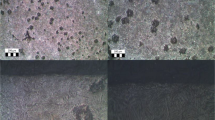Abstract
In this study, the machinability of austempered ductile iron (ADI) having a ferritic structure was examined. For this purpose, three types of ductile iron materials (as cast, ADI-250, ADI-375) and two different types of cutting tool materials (ceramics and cermet) were used. To emphasize the role of austempering process, ductile iron (DI) specimens are first austenitized in salt bath at 900°C for 120 minutes after which they are quenched in salt bath at 250°C (ADI-250) and 375°C (ADI-375) for 120 min. Machining tests were carried out at various cutting speeds (100–500 m/min) under the constant depth of cut and feed rate. The performance of both ceramic and cermet tools were evaluated based on the workpiece surface roughness and flank wear. Wear conditions of the cutting tools were characterized by scanning electron microscope. The results point out that the lower austempering temperature results in increasing of the cutting forces, while better surface roughness is obtained. Additionally, the results indicate that the tool wear occurs mainly on the flank face. However, higher cutting speed results in chipping formation in cermet cutting tool.
Similar content being viewed by others
References
Ji C, Zhu S (2006) Study of a new type ductile iron for rolling: composition design (1). Mater Sci Eng A 419:318–325. doi:10.1016/j.msea.2006.01.020
Sohi MH, Ahmadabadi MN, Vahdat AB (2004) The role of austempering parameters on the structure and mechanical properties of heavy section ADI. J Mater Process Technol 153–154:203–208. doi:10.1016/j.jmatprotec.2004.04.308
Seker U, Hasirci H (2006) Evaluation of machinability of austempered ductile irons in terms of cutting forces and surface quality. J Mater Process Technol 173:260–268. doi:10.1016/j.jmatprotec.2005.05.058
Cakir MC, Bayram A, Isik Y, Salar B (2005) The effects of austempering temperature and time onto the machinability of austempered ductile iron. Mater Sci Eng A 407:147–153. doi:10.1016/j.msea.2005.07.005
Seker U, Ciftci I, Hasirci H (2003) The effect of alloying elements on surface roughness and cutting forces during machining of ductile iron. Mater Des 24:47–51. doi:10.1016/S0261–3069(02)00081-X
Bhattacharyya SK, Ezugwu EO, Jawahid A (1989) The performance of ceramic tool materials for the machining of cast iron. Wear 135:147–159. doi:10.1016/0043–1648(89)90102–6
Ghani AK, Choudhary A Husni (2002) Study of tool life, surface roughness and vibration in machining nodular cast iron with ceramic tool. J Mater Process Technol 127:17–22. doi:10.1016/S0924–0136(02)00092–4
Camuscu N (2006) Effect of cutting speed on the performance of Al2O3 based ceramic tools in turning nodular cast iron. Material Des 27:997–1006. doi:10.1016/j.matdes.2005.02.011
Liu N, Han C, Yang H, Xu Y, Shi M, Chao S, Xie F (2005) The milling performances of TiC-based cermet tools with TiN nanopowders addition against normalized medium carbon steel AISI1045. Wear 258:1688–1695
Qian L, Hossan MR (2007) Effect on cutting force in turning hardened tool steels with cubic boron nitride inserts. J Mater Process Technol 191:274–278. doi:10.1016/j.jmatprotec.2007.03.022
Yen YC, Jain A, Altan T (2004) A finite element analysis of orthogonal machining using different tool edge geometries. J Mater Process Technol 146:72–81. doi:10.1016/S0924-0136(03)00846-X
Author information
Authors and Affiliations
Corresponding author
Rights and permissions
About this article
Cite this article
Aslantas, K., Ucun, I. The performance of ceramic and cermet cutting tools for the machining of austempered ductile iron. Int J Adv Manuf Technol 41, 642–650 (2009). https://doi.org/10.1007/s00170-008-1528-z
Received:
Accepted:
Published:
Issue Date:
DOI: https://doi.org/10.1007/s00170-008-1528-z




